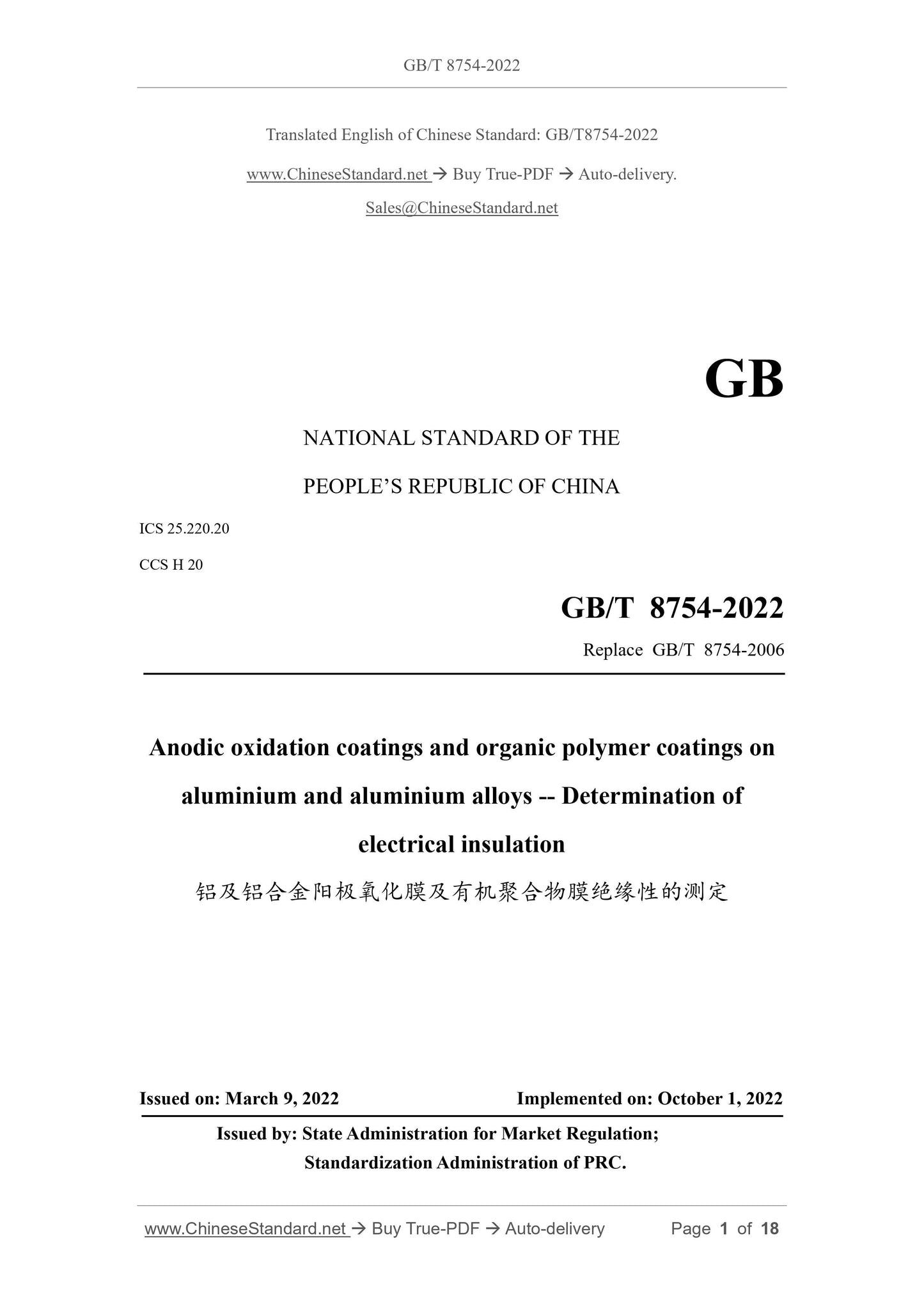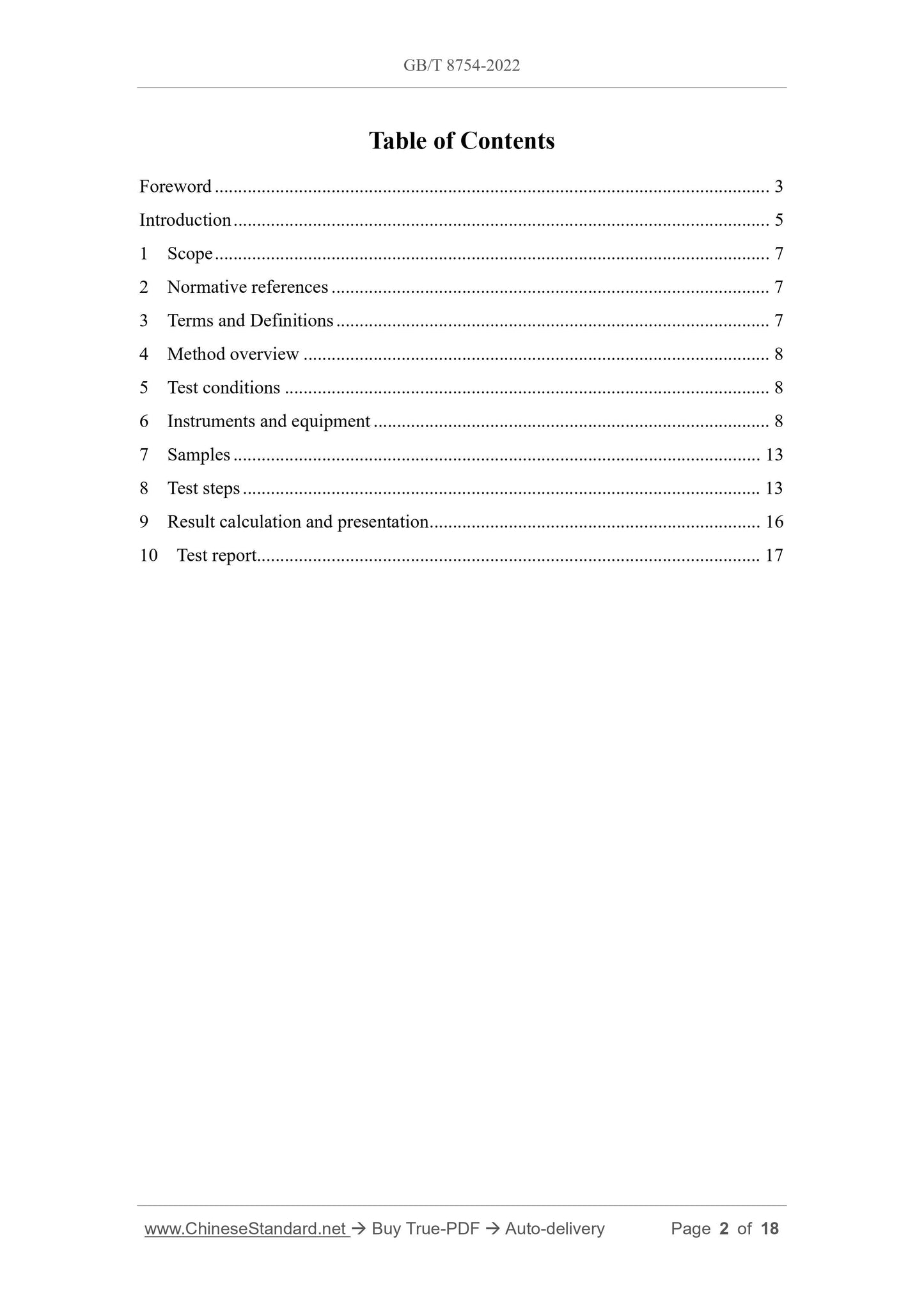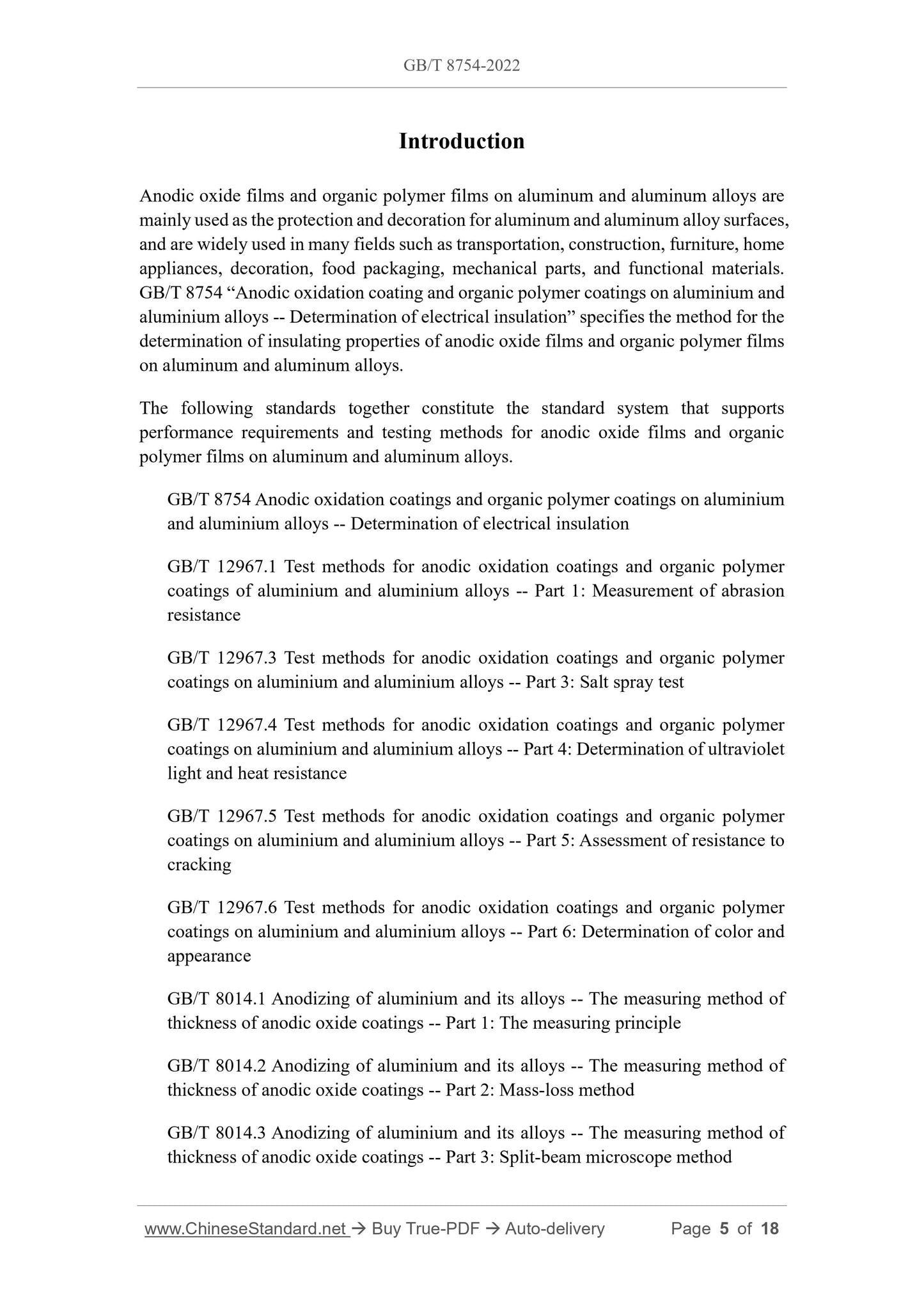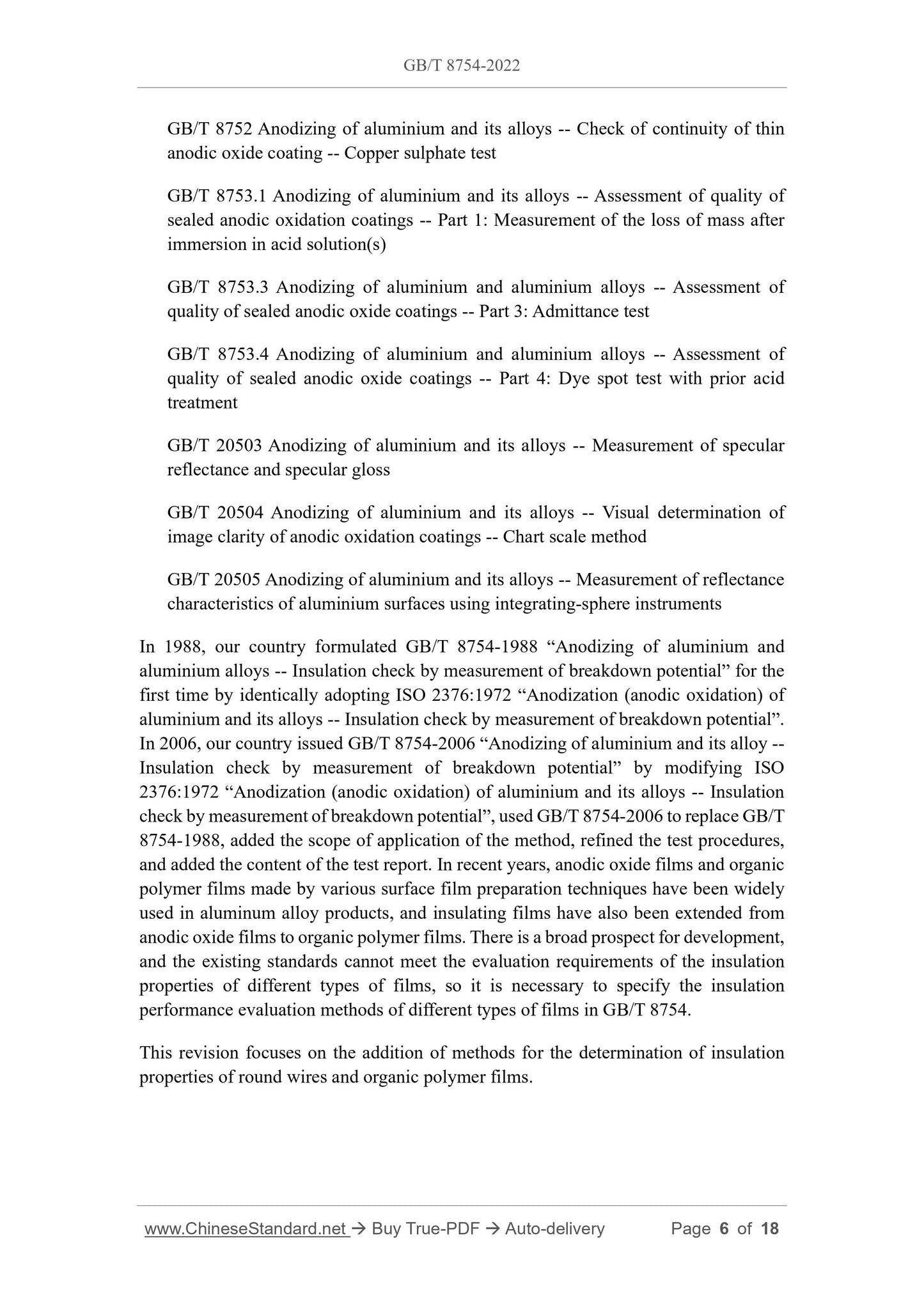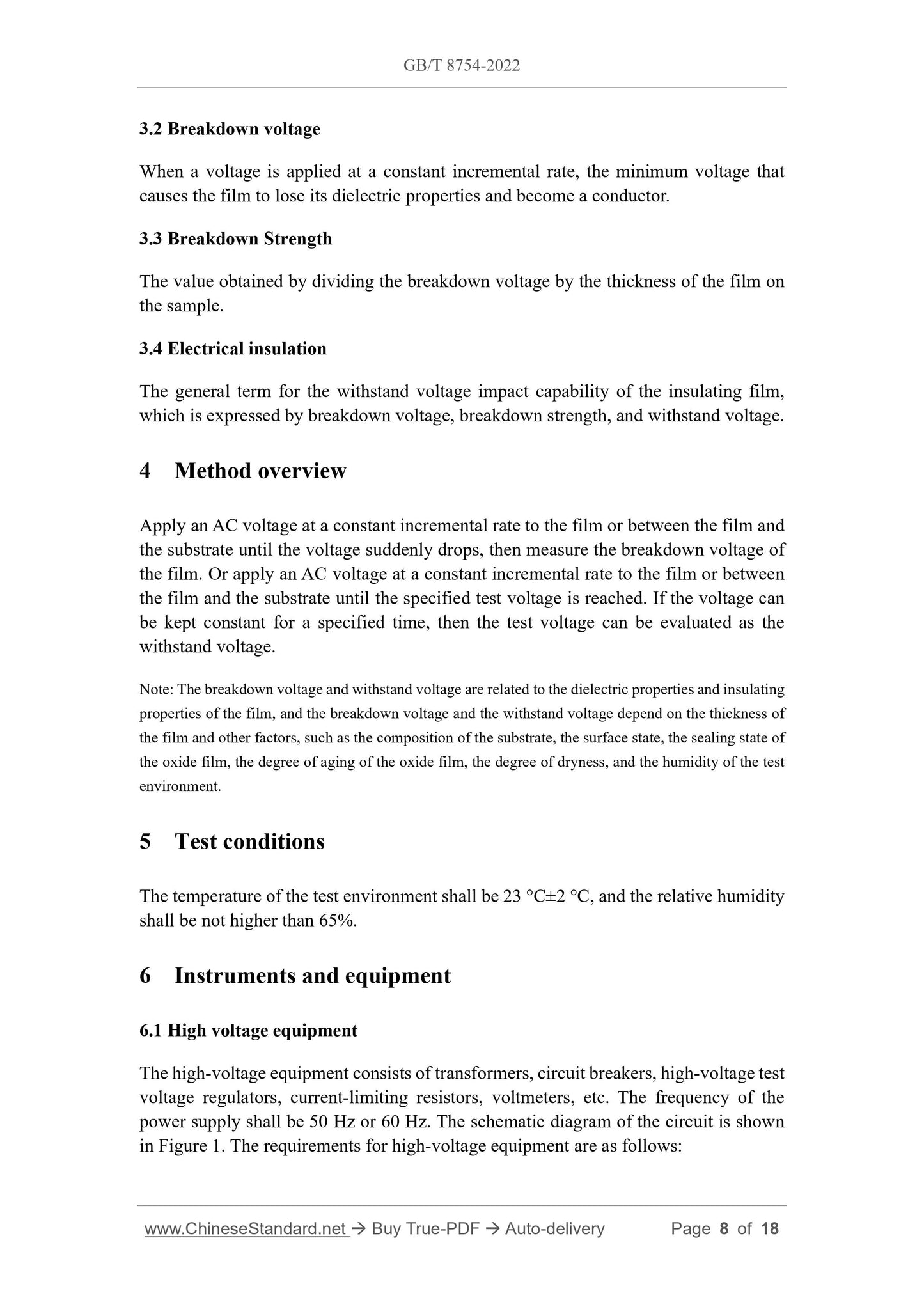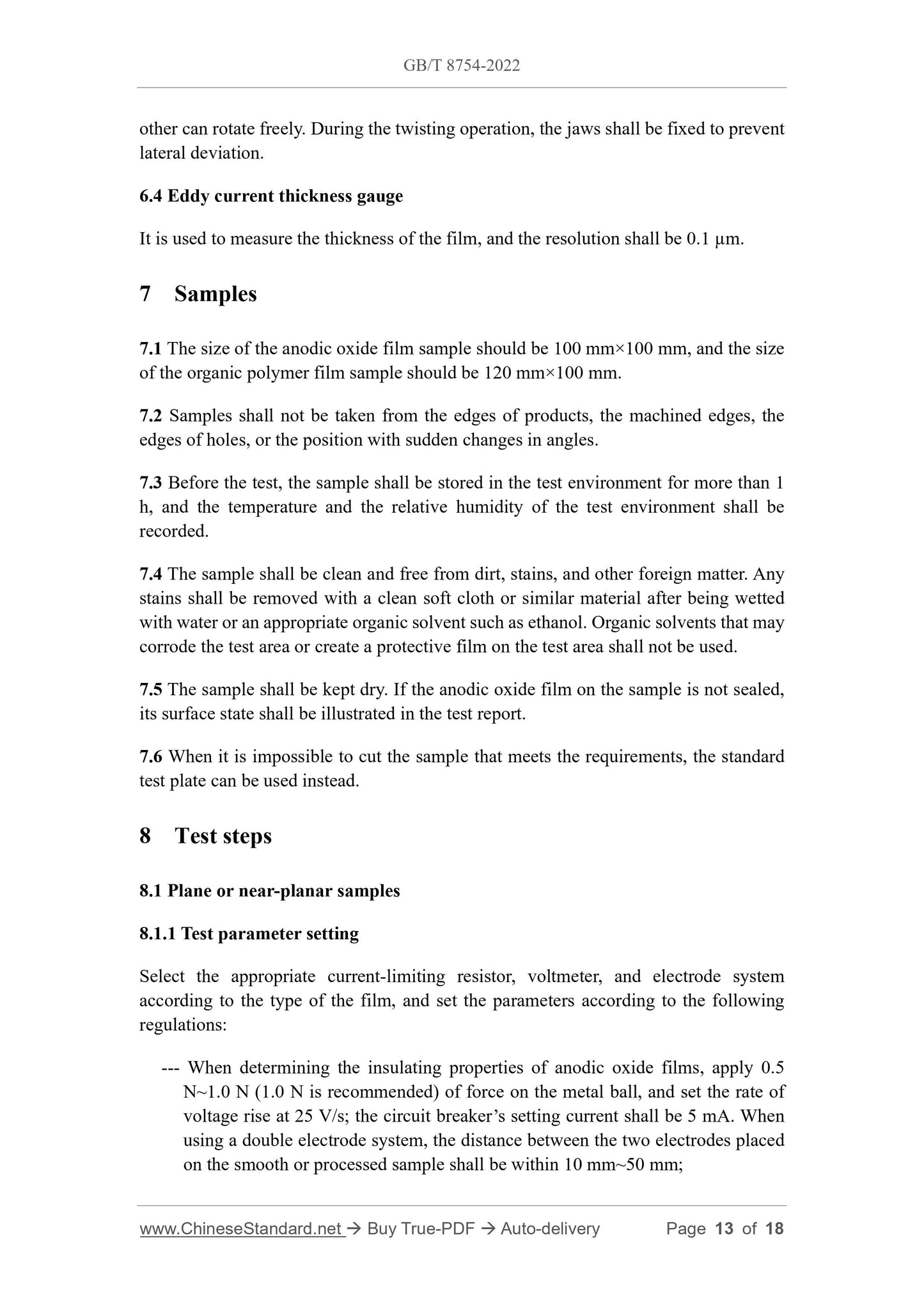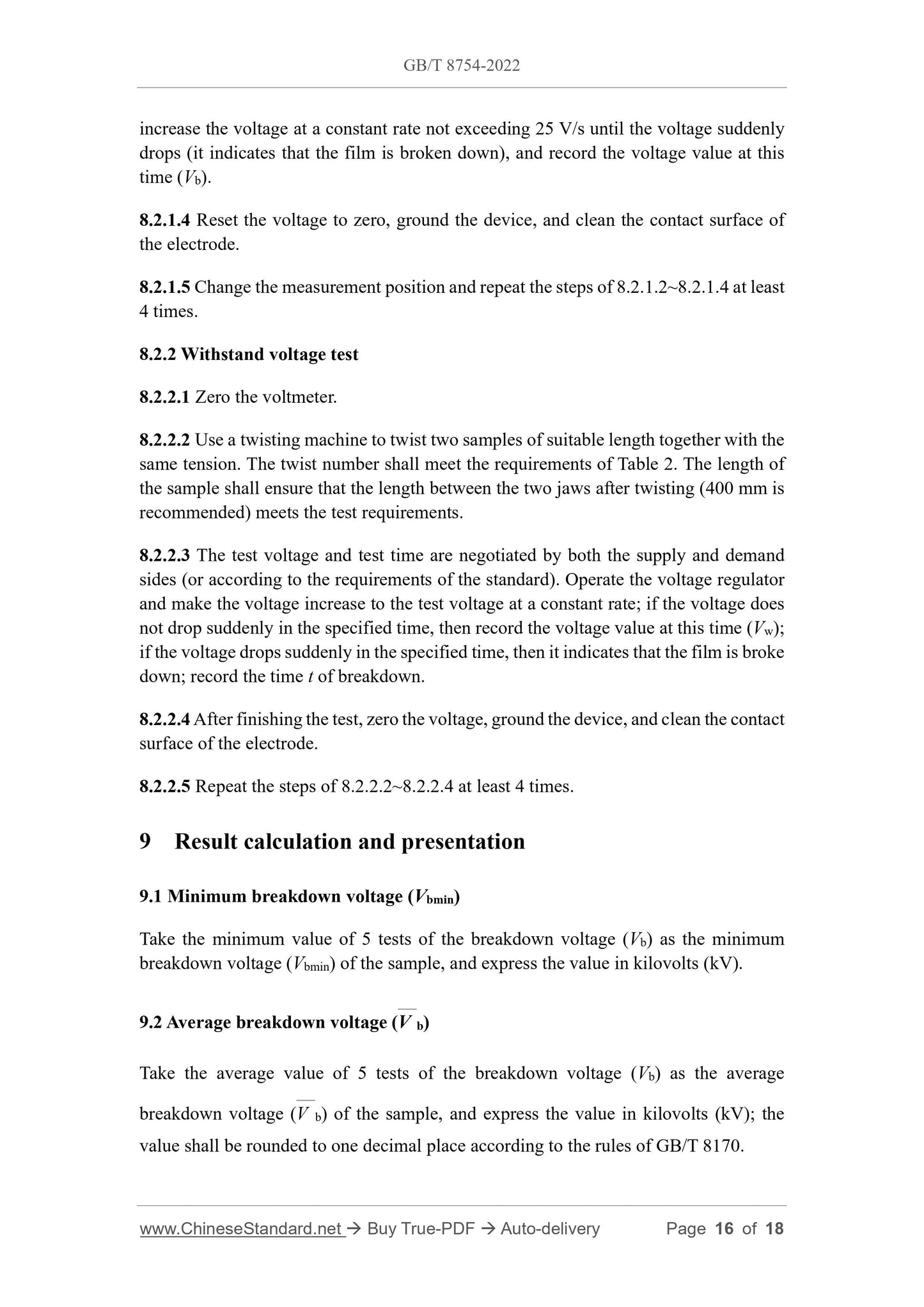1
/
of
7
www.ChineseStandard.us -- Field Test Asia Pte. Ltd.
GB/T 8754-2022 English PDF (GB/T8754-2022)
GB/T 8754-2022 English PDF (GB/T8754-2022)
Regular price
$185.00
Regular price
Sale price
$185.00
Unit price
/
per
Shipping calculated at checkout.
Couldn't load pickup availability
GB/T 8754-2022: Anodic oxidation coatings and organic polymer coatings on aluminium and aluminium alloys - Determination of electrical insulation
Delivery: 9 seconds. Download (& Email) true-PDF + Invoice.
Get Quotation: Click GB/T 8754-2022 (Self-service in 1-minute)
Historical versions (Master-website): GB/T 8754-2022
Preview True-PDF (Reload/Scroll-down if blank)
GB/T 8754-2022
NATIONAL STANDARD OF THE
PEOPLE’S REPUBLIC OF CHINA
ICS 25.220.20
CCS H 20
Replace GB/T 8754-2006
Anodic oxidation coatings and organic polymer coatings on
aluminium and aluminium alloys -- Determination of
electrical insulation
ISSUED ON: MARCH 9, 2022
IMPLEMENTED ON: OCTOBER 1, 2022
Issued by: State Administration for Market Regulation;
Standardization Administration of PRC.
Table of Contents
Foreword ... 3
Introduction ... 5
1 Scope ... 7
2 Normative references ... 7
3 Terms and Definitions ... 7
4 Method overview ... 8
5 Test conditions ... 8
6 Instruments and equipment ... 8
7 Samples ... 13
8 Test steps ... 13
9 Result calculation and presentation ... 16
10 Test report... 17
Introduction
Anodic oxide films and organic polymer films on aluminum and aluminum alloys are
mainly used as the protection and decoration for aluminum and aluminum alloy surfaces,
and are widely used in many fields such as transportation, construction, furniture, home
appliances, decoration, food packaging, mechanical parts, and functional materials.
GB/T 8754 “Anodic oxidation coating and organic polymer coatings on aluminium and
aluminium alloys -- Determination of electrical insulation” specifies the method for the
determination of insulating properties of anodic oxide films and organic polymer films
on aluminum and aluminum alloys.
The following standards together constitute the standard system that supports
performance requirements and testing methods for anodic oxide films and organic
polymer films on aluminum and aluminum alloys.
GB/T 8754 Anodic oxidation coatings and organic polymer coatings on aluminium
and aluminium alloys -- Determination of electrical insulation
GB/T 12967.1 Test methods for anodic oxidation coatings and organic polymer
coatings of aluminium and aluminium alloys -- Part 1: Measurement of abrasion
resistance
GB/T 12967.3 Test methods for anodic oxidation coatings and organic polymer
coatings on aluminium and aluminium alloys -- Part 3: Salt spray test
GB/T 12967.4 Test methods for anodic oxidation coatings and organic polymer
coatings on aluminium and aluminium alloys -- Part 4: Determination of ultraviolet
light and heat resistance
GB/T 12967.5 Test methods for anodic oxidation coatings and organic polymer
coatings on aluminium and aluminium alloys -- Part 5: Assessment of resistance to
cracking
GB/T 12967.6 Test methods for anodic oxidation coatings and organic polymer
coatings on aluminium and aluminium alloys -- Part 6: Determination of color and
appearance
GB/T 8014.1 Anodizing of aluminium and its alloys -- The measuring method of
thickness of anodic oxide coatings -- Part 1: The measuring principle
GB/T 8014.2 Anodizing of aluminium and its alloys -- The measuring method of
thickness of anodic oxide coatings -- Part 2: Mass-loss method
GB/T 8014.3 Anodizing of aluminium and its alloys -- The measuring method of
thickness of anodic oxide coatings -- Part 3: Split-beam microscope method
GB/T 8752 Anodizing of aluminium and its alloys -- Check of continuity of thin
anodic oxide coating -- Copper sulphate test
GB/T 8753.1 Anodizing of aluminium and its alloys -- Assessment of quality of
sealed anodic oxidation coatings -- Part 1: Measurement of the loss of mass after
immersion in acid solution(s)
GB/T 8753.3 Anodizing of aluminium and aluminium alloys -- Assessment of
quality of sealed anodic oxide coatings -- Part 3: Admittance test
GB/T 8753.4 Anodizing of aluminium and aluminium alloys -- Assessment of
quality of sealed anodic oxide coatings -- Part 4: Dye spot test with prior acid
treatment
GB/T 20503 Anodizing of aluminium and its alloys -- Measurement of specular
reflectance and specular gloss
GB/T 20504 Anodizing of aluminium and its alloys -- Visual determination of
image clarity of anodic oxidation coatings -- Chart scale method
GB/T 20505 Anodizing of aluminium and its alloys -- Measurement of reflectance
characteristics of aluminium surfaces using integrating-sphere instruments
In 1988, our country formulated GB/T 8754-1988 “Anodizing of aluminium and
aluminium alloys -- Insulation check by measurement of breakdown potential” for the
first time by identically adopting ISO 2376:1972 “Anodization (anodic oxidation) of
aluminium and its alloys -- Insulation check by measurement of breakdown potential”.
In 2006, our country issued GB/T 8754-2006 “Anodizing of aluminium and its alloy --
Insulation check by measurement of breakdown potential” by modifying ISO
2376:1972 “Anodization (anodic oxidation) of aluminium and its alloys -- Insulation
check by measurement of breakdown potential”, used GB/T 8754-2006 to replace GB/T
8754-1988, added the scope of application of the method, refined the test procedures,
and added the content of the test report. In recent years, anodic oxide films and organic
polymer films made by various surface film preparation techniques have been widely
used in aluminum alloy products, and insulating films have also been extended from
anodic oxide films to organic polymer films. There is a broad prospect for development,
and the existing standards cannot meet the evaluation requirements of the insulation
properties of different types of films, so it is necessary to specify the insulation
performance evaluation methods of different types of films in GB/T 8754.
This revision focuses on the addition of methods for the determination of insulation
properties of round wires and organic polymer films.
3.2 Breakdown voltage
When a voltage is applied at a constant incremental rate, the minimum voltage that
causes the film to lose its dielectric properties and become a conductor.
3.3 Breakdown Strength
The value obtained by dividing the breakdown voltage by the thickness of the film on
the sample.
3.4 Electrical insulation
The general term for the withstand voltage impact capability of the insulating film,
which is expressed by breakdown voltage, breakdown strength, and withstand voltage.
4 Method overview
Apply an AC voltage at a constant incremental rate to the film or between the film and
the substrate until the voltage suddenly drops, then measure the breakdown voltage of
the film. Or apply an AC voltage at a constant incremental rate to the film or between
the film and the substrate until the specified test voltage is reached. If the voltage can
be kept constant for a specified time, then the test voltage can be evaluated as the
withstand voltage.
Note: The breakdown voltage and withstand voltage are related to the dielectric properties and insulating
properties of the film, and the breakdown voltage and the withstand voltage depend on the thickness of
the film and other factors, such as the composition of the substrate, the surface state, the sealing state of
the oxide film, the degree of aging of the oxide film, the degree of dryness, and the humidity of the test
environment.
5 Test conditions
The temperature of the test environment shall be 23 °C±2 °C, and the relative humidity
shall be not higher than 65%.
6 Instruments and equipment
6.1 High voltage equipment
The high-voltage equipment consists of transformers, circuit breakers, high-voltage test
voltage regulators, current-limiting resistors, voltmeters, etc. The frequency of the
power supply shall be 50 Hz or 60 Hz. The schematic diagram of the circuit is shown
in Figure 1. The requirements for high-voltage equipment are as follows:
other can rotate freely. During the twisting operation, the jaws shall be fixed to prevent
lateral deviation.
6.4 Eddy current thickness gauge
It is used to measure the thickness of the film, and the resolution shall be 0.1 µm.
7 Samples
7.1 The size of the anodic oxide film sample should be 100 mm×100 mm, and the size
of the organic polymer film sample should be 120 mm×100 mm.
7.2 Samples shall not be taken from the edges of products, the machined edges, the
edges of holes, or the position with sudden changes in angles.
7.3 Before the test, the sample shall be stored in the test environment for more than 1
h, and the temperature and the relative humidity of the test environment shall be
recorded.
7.4 The sample shall be clean and free from dirt, stains, and other foreign matter. Any
stains shall be removed with a clean soft cloth or similar material after being wetted
with water or an appropriate organic solvent such as ethanol. Organic solvents that may
corrode the test area or create a protective film on the test area shall not be used.
7.5 The sample shall be kept dry. If the anodic oxide film on the sample is not sealed,
its surface state shall be illustrated in the test report.
7.6 When it is impossible to cut the sample that meets the requirements, the standard
test plate can be used instead.
8 Test steps
8.1 Plane or near-planar samples
8.1.1 Test parameter setting
Select the appropriate current-limiting resistor, voltmeter, and electrode system
according to the type of the film, and set the parameters according to the following
regulations:
--- When determining the insulating properties of anodic oxide films, apply 0.5
N~1.0 N (1.0 N is recommended) of force on the metal ball, and set the rate of
voltage rise at 25 V/s; the circuit breaker’s setting current shall be 5 mA. When
using a double electrode system, the distance between the two electrodes placed
on the smooth or processed sample shall be within 10 mm~50 mm;
increase the voltage at a constant rate not exceeding 25 V/s until the voltage suddenly
drops (it indicates that the film is broken down), and record the voltage value at this
time (Vb).
8.2.1.4 Reset the voltage to zero, ground the device, and clean the contact surface of
the electrode.
8.2.1.5 Change the measurement position and repeat the steps of 8.2.1.2~8.2.1.4 at least
4 times.
8.2.2 Withstand voltage test
8.2.2.1 Zero the voltmeter.
8.2.2.2 Use a twisting machine to twist two samples of suitable length together with the
same tension. The twist number shall meet the requirements of Table 2. The length of
the sample shall ensure that the length between the two jaws after twisting (400 mm is
recommended) meets the test requirements.
8.2.2.3 The test voltage and test time are negotiated by both the supply and demand
sides (or according to the requirements of the standard). Operate the voltage regulator
and make the voltage increase to the test voltage at a constant rate; if the voltage does
not drop suddenly in the specified time, then record the voltage value at this time (Vw);
if the voltage drops suddenly in the specified time, then it indicates that the film is broke
down; record the time t of breakdown.
8.2.2.4 After finishing the test, zero the voltage, ground the device, and clean the contact
surface of the electrode.
8.2.2.5 Repeat the steps of 8.2.2.2~8.2.2.4 at least 4 times.
9 Result calculation and presentation
9.1 Minimum breakdown voltage (Vbmin)
Take the minimum value of 5 tests of the breakdown voltage (Vb) as the minimum
breakdown voltage (Vbmin) of the sample, and express the value in kilovolts (kV).
9.2 Average breakdown voltage (V——b)
Take the average value of 5 tests of the breakdown voltage (Vb) as the average
breakdown voltage (V——b) of the sample, and express the value in kilovolts (kV); the
value shall be rounded to one decimal place according to the rules of GB/T 8170.
GB/T 8754-2022
NATIONAL STANDARD OF THE
PEOPLE’S REPUBLIC OF CHINA
ICS 25.220.20
CCS H 20
Replace GB/T 8754-2006
Anodic oxidation coatings and organic polymer coatings on
aluminium and aluminium alloys -- Determination of
electrical insulation
ISSUED ON: MARCH 9, 2022
IMPLEMENTED ON: OCTOBER 1, 2022
Issued by: State Administration for Market Regulation;
Standardization Administration of PRC.
Table of Contents
Foreword ... 3
Introduction ... 5
1 Scope ... 7
2 Normative references ... 7
3 Terms and Definitions ... 7
4 Method overview ... 8
5 Test conditions ... 8
6 Instruments and equipment ... 8
7 Samples ... 13
8 Test steps ... 13
9 Result calculation and presentation ... 16
10 Test report... 17
Introduction
Anodic oxide films and organic polymer films on aluminum and aluminum alloys are
mainly used as the protection and decoration for aluminum and aluminum alloy surfaces,
and are widely used in many fields such as transportation, construction, furniture, home
appliances, decoration, food packaging, mechanical parts, and functional materials.
GB/T 8754 “Anodic oxidation coating and organic polymer coatings on aluminium and
aluminium alloys -- Determination of electrical insulation” specifies the method for the
determination of insulating properties of anodic oxide films and organic polymer films
on aluminum and aluminum alloys.
The following standards together constitute the standard system that supports
performance requirements and testing methods for anodic oxide films and organic
polymer films on aluminum and aluminum alloys.
GB/T 8754 Anodic oxidation coatings and organic polymer coatings on aluminium
and aluminium alloys -- Determination of electrical insulation
GB/T 12967.1 Test methods for anodic oxidation coatings and organic polymer
coatings of aluminium and aluminium alloys -- Part 1: Measurement of abrasion
resistance
GB/T 12967.3 Test methods for anodic oxidation coatings and organic polymer
coatings on aluminium and aluminium alloys -- Part 3: Salt spray test
GB/T 12967.4 Test methods for anodic oxidation coatings and organic polymer
coatings on aluminium and aluminium alloys -- Part 4: Determination of ultraviolet
light and heat resistance
GB/T 12967.5 Test methods for anodic oxidation coatings and organic polymer
coatings on aluminium and aluminium alloys -- Part 5: Assessment of resistance to
cracking
GB/T 12967.6 Test methods for anodic oxidation coatings and organic polymer
coatings on aluminium and aluminium alloys -- Part 6: Determination of color and
appearance
GB/T 8014.1...
Delivery: 9 seconds. Download (& Email) true-PDF + Invoice.
Get Quotation: Click GB/T 8754-2022 (Self-service in 1-minute)
Historical versions (Master-website): GB/T 8754-2022
Preview True-PDF (Reload/Scroll-down if blank)
GB/T 8754-2022
NATIONAL STANDARD OF THE
PEOPLE’S REPUBLIC OF CHINA
ICS 25.220.20
CCS H 20
Replace GB/T 8754-2006
Anodic oxidation coatings and organic polymer coatings on
aluminium and aluminium alloys -- Determination of
electrical insulation
ISSUED ON: MARCH 9, 2022
IMPLEMENTED ON: OCTOBER 1, 2022
Issued by: State Administration for Market Regulation;
Standardization Administration of PRC.
Table of Contents
Foreword ... 3
Introduction ... 5
1 Scope ... 7
2 Normative references ... 7
3 Terms and Definitions ... 7
4 Method overview ... 8
5 Test conditions ... 8
6 Instruments and equipment ... 8
7 Samples ... 13
8 Test steps ... 13
9 Result calculation and presentation ... 16
10 Test report... 17
Introduction
Anodic oxide films and organic polymer films on aluminum and aluminum alloys are
mainly used as the protection and decoration for aluminum and aluminum alloy surfaces,
and are widely used in many fields such as transportation, construction, furniture, home
appliances, decoration, food packaging, mechanical parts, and functional materials.
GB/T 8754 “Anodic oxidation coating and organic polymer coatings on aluminium and
aluminium alloys -- Determination of electrical insulation” specifies the method for the
determination of insulating properties of anodic oxide films and organic polymer films
on aluminum and aluminum alloys.
The following standards together constitute the standard system that supports
performance requirements and testing methods for anodic oxide films and organic
polymer films on aluminum and aluminum alloys.
GB/T 8754 Anodic oxidation coatings and organic polymer coatings on aluminium
and aluminium alloys -- Determination of electrical insulation
GB/T 12967.1 Test methods for anodic oxidation coatings and organic polymer
coatings of aluminium and aluminium alloys -- Part 1: Measurement of abrasion
resistance
GB/T 12967.3 Test methods for anodic oxidation coatings and organic polymer
coatings on aluminium and aluminium alloys -- Part 3: Salt spray test
GB/T 12967.4 Test methods for anodic oxidation coatings and organic polymer
coatings on aluminium and aluminium alloys -- Part 4: Determination of ultraviolet
light and heat resistance
GB/T 12967.5 Test methods for anodic oxidation coatings and organic polymer
coatings on aluminium and aluminium alloys -- Part 5: Assessment of resistance to
cracking
GB/T 12967.6 Test methods for anodic oxidation coatings and organic polymer
coatings on aluminium and aluminium alloys -- Part 6: Determination of color and
appearance
GB/T 8014.1 Anodizing of aluminium and its alloys -- The measuring method of
thickness of anodic oxide coatings -- Part 1: The measuring principle
GB/T 8014.2 Anodizing of aluminium and its alloys -- The measuring method of
thickness of anodic oxide coatings -- Part 2: Mass-loss method
GB/T 8014.3 Anodizing of aluminium and its alloys -- The measuring method of
thickness of anodic oxide coatings -- Part 3: Split-beam microscope method
GB/T 8752 Anodizing of aluminium and its alloys -- Check of continuity of thin
anodic oxide coating -- Copper sulphate test
GB/T 8753.1 Anodizing of aluminium and its alloys -- Assessment of quality of
sealed anodic oxidation coatings -- Part 1: Measurement of the loss of mass after
immersion in acid solution(s)
GB/T 8753.3 Anodizing of aluminium and aluminium alloys -- Assessment of
quality of sealed anodic oxide coatings -- Part 3: Admittance test
GB/T 8753.4 Anodizing of aluminium and aluminium alloys -- Assessment of
quality of sealed anodic oxide coatings -- Part 4: Dye spot test with prior acid
treatment
GB/T 20503 Anodizing of aluminium and its alloys -- Measurement of specular
reflectance and specular gloss
GB/T 20504 Anodizing of aluminium and its alloys -- Visual determination of
image clarity of anodic oxidation coatings -- Chart scale method
GB/T 20505 Anodizing of aluminium and its alloys -- Measurement of reflectance
characteristics of aluminium surfaces using integrating-sphere instruments
In 1988, our country formulated GB/T 8754-1988 “Anodizing of aluminium and
aluminium alloys -- Insulation check by measurement of breakdown potential” for the
first time by identically adopting ISO 2376:1972 “Anodization (anodic oxidation) of
aluminium and its alloys -- Insulation check by measurement of breakdown potential”.
In 2006, our country issued GB/T 8754-2006 “Anodizing of aluminium and its alloy --
Insulation check by measurement of breakdown potential” by modifying ISO
2376:1972 “Anodization (anodic oxidation) of aluminium and its alloys -- Insulation
check by measurement of breakdown potential”, used GB/T 8754-2006 to replace GB/T
8754-1988, added the scope of application of the method, refined the test procedures,
and added the content of the test report. In recent years, anodic oxide films and organic
polymer films made by various surface film preparation techniques have been widely
used in aluminum alloy products, and insulating films have also been extended from
anodic oxide films to organic polymer films. There is a broad prospect for development,
and the existing standards cannot meet the evaluation requirements of the insulation
properties of different types of films, so it is necessary to specify the insulation
performance evaluation methods of different types of films in GB/T 8754.
This revision focuses on the addition of methods for the determination of insulation
properties of round wires and organic polymer films.
3.2 Breakdown voltage
When a voltage is applied at a constant incremental rate, the minimum voltage that
causes the film to lose its dielectric properties and become a conductor.
3.3 Breakdown Strength
The value obtained by dividing the breakdown voltage by the thickness of the film on
the sample.
3.4 Electrical insulation
The general term for the withstand voltage impact capability of the insulating film,
which is expressed by breakdown voltage, breakdown strength, and withstand voltage.
4 Method overview
Apply an AC voltage at a constant incremental rate to the film or between the film and
the substrate until the voltage suddenly drops, then measure the breakdown voltage of
the film. Or apply an AC voltage at a constant incremental rate to the film or between
the film and the substrate until the specified test voltage is reached. If the voltage can
be kept constant for a specified time, then the test voltage can be evaluated as the
withstand voltage.
Note: The breakdown voltage and withstand voltage are related to the dielectric properties and insulating
properties of the film, and the breakdown voltage and the withstand voltage depend on the thickness of
the film and other factors, such as the composition of the substrate, the surface state, the sealing state of
the oxide film, the degree of aging of the oxide film, the degree of dryness, and the humidity of the test
environment.
5 Test conditions
The temperature of the test environment shall be 23 °C±2 °C, and the relative humidity
shall be not higher than 65%.
6 Instruments and equipment
6.1 High voltage equipment
The high-voltage equipment consists of transformers, circuit breakers, high-voltage test
voltage regulators, current-limiting resistors, voltmeters, etc. The frequency of the
power supply shall be 50 Hz or 60 Hz. The schematic diagram of the circuit is shown
in Figure 1. The requirements for high-voltage equipment are as follows:
other can rotate freely. During the twisting operation, the jaws shall be fixed to prevent
lateral deviation.
6.4 Eddy current thickness gauge
It is used to measure the thickness of the film, and the resolution shall be 0.1 µm.
7 Samples
7.1 The size of the anodic oxide film sample should be 100 mm×100 mm, and the size
of the organic polymer film sample should be 120 mm×100 mm.
7.2 Samples shall not be taken from the edges of products, the machined edges, the
edges of holes, or the position with sudden changes in angles.
7.3 Before the test, the sample shall be stored in the test environment for more than 1
h, and the temperature and the relative humidity of the test environment shall be
recorded.
7.4 The sample shall be clean and free from dirt, stains, and other foreign matter. Any
stains shall be removed with a clean soft cloth or similar material after being wetted
with water or an appropriate organic solvent such as ethanol. Organic solvents that may
corrode the test area or create a protective film on the test area shall not be used.
7.5 The sample shall be kept dry. If the anodic oxide film on the sample is not sealed,
its surface state shall be illustrated in the test report.
7.6 When it is impossible to cut the sample that meets the requirements, the standard
test plate can be used instead.
8 Test steps
8.1 Plane or near-planar samples
8.1.1 Test parameter setting
Select the appropriate current-limiting resistor, voltmeter, and electrode system
according to the type of the film, and set the parameters according to the following
regulations:
--- When determining the insulating properties of anodic oxide films, apply 0.5
N~1.0 N (1.0 N is recommended) of force on the metal ball, and set the rate of
voltage rise at 25 V/s; the circuit breaker’s setting current shall be 5 mA. When
using a double electrode system, the distance between the two electrodes placed
on the smooth or processed sample shall be within 10 mm~50 mm;
increase the voltage at a constant rate not exceeding 25 V/s until the voltage suddenly
drops (it indicates that the film is broken down), and record the voltage value at this
time (Vb).
8.2.1.4 Reset the voltage to zero, ground the device, and clean the contact surface of
the electrode.
8.2.1.5 Change the measurement position and repeat the steps of 8.2.1.2~8.2.1.4 at least
4 times.
8.2.2 Withstand voltage test
8.2.2.1 Zero the voltmeter.
8.2.2.2 Use a twisting machine to twist two samples of suitable length together with the
same tension. The twist number shall meet the requirements of Table 2. The length of
the sample shall ensure that the length between the two jaws after twisting (400 mm is
recommended) meets the test requirements.
8.2.2.3 The test voltage and test time are negotiated by both the supply and demand
sides (or according to the requirements of the standard). Operate the voltage regulator
and make the voltage increase to the test voltage at a constant rate; if the voltage does
not drop suddenly in the specified time, then record the voltage value at this time (Vw);
if the voltage drops suddenly in the specified time, then it indicates that the film is broke
down; record the time t of breakdown.
8.2.2.4 After finishing the test, zero the voltage, ground the device, and clean the contact
surface of the electrode.
8.2.2.5 Repeat the steps of 8.2.2.2~8.2.2.4 at least 4 times.
9 Result calculation and presentation
9.1 Minimum breakdown voltage (Vbmin)
Take the minimum value of 5 tests of the breakdown voltage (Vb) as the minimum
breakdown voltage (Vbmin) of the sample, and express the value in kilovolts (kV).
9.2 Average breakdown voltage (V——b)
Take the average value of 5 tests of the breakdown voltage (Vb) as the average
breakdown voltage (V——b) of the sample, and express the value in kilovolts (kV); the
value shall be rounded to one decimal place according to the rules of GB/T 8170.
GB/T 8754-2022
NATIONAL STANDARD OF THE
PEOPLE’S REPUBLIC OF CHINA
ICS 25.220.20
CCS H 20
Replace GB/T 8754-2006
Anodic oxidation coatings and organic polymer coatings on
aluminium and aluminium alloys -- Determination of
electrical insulation
ISSUED ON: MARCH 9, 2022
IMPLEMENTED ON: OCTOBER 1, 2022
Issued by: State Administration for Market Regulation;
Standardization Administration of PRC.
Table of Contents
Foreword ... 3
Introduction ... 5
1 Scope ... 7
2 Normative references ... 7
3 Terms and Definitions ... 7
4 Method overview ... 8
5 Test conditions ... 8
6 Instruments and equipment ... 8
7 Samples ... 13
8 Test steps ... 13
9 Result calculation and presentation ... 16
10 Test report... 17
Introduction
Anodic oxide films and organic polymer films on aluminum and aluminum alloys are
mainly used as the protection and decoration for aluminum and aluminum alloy surfaces,
and are widely used in many fields such as transportation, construction, furniture, home
appliances, decoration, food packaging, mechanical parts, and functional materials.
GB/T 8754 “Anodic oxidation coating and organic polymer coatings on aluminium and
aluminium alloys -- Determination of electrical insulation” specifies the method for the
determination of insulating properties of anodic oxide films and organic polymer films
on aluminum and aluminum alloys.
The following standards together constitute the standard system that supports
performance requirements and testing methods for anodic oxide films and organic
polymer films on aluminum and aluminum alloys.
GB/T 8754 Anodic oxidation coatings and organic polymer coatings on aluminium
and aluminium alloys -- Determination of electrical insulation
GB/T 12967.1 Test methods for anodic oxidation coatings and organic polymer
coatings of aluminium and aluminium alloys -- Part 1: Measurement of abrasion
resistance
GB/T 12967.3 Test methods for anodic oxidation coatings and organic polymer
coatings on aluminium and aluminium alloys -- Part 3: Salt spray test
GB/T 12967.4 Test methods for anodic oxidation coatings and organic polymer
coatings on aluminium and aluminium alloys -- Part 4: Determination of ultraviolet
light and heat resistance
GB/T 12967.5 Test methods for anodic oxidation coatings and organic polymer
coatings on aluminium and aluminium alloys -- Part 5: Assessment of resistance to
cracking
GB/T 12967.6 Test methods for anodic oxidation coatings and organic polymer
coatings on aluminium and aluminium alloys -- Part 6: Determination of color and
appearance
GB/T 8014.1...
Share
